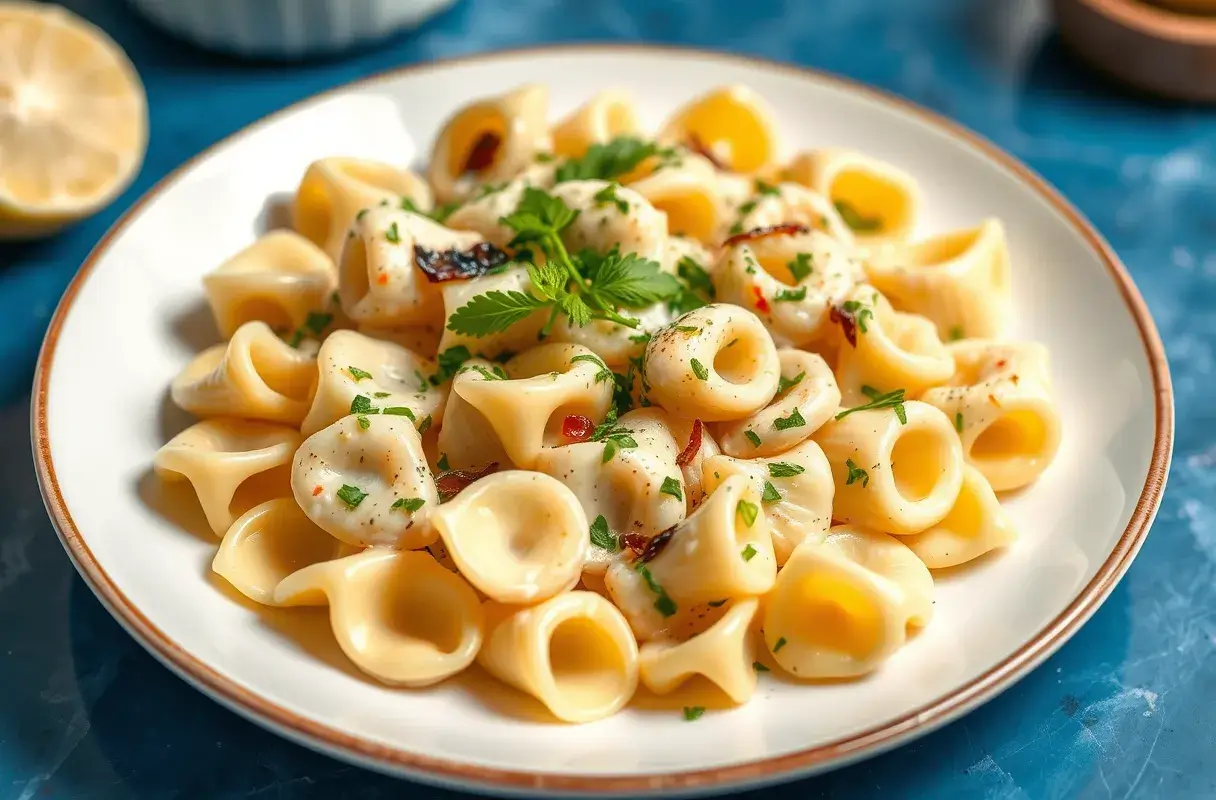Prep Time: 10 minutes
Cook Time: 15 minutes
Servings: 4
Understanding Farfalle and Bow Tie Pasta
When it comes to pasta, few shapes inspire as much curiosity as Farfalle pasta . Indeed, this butterfly-like pasta often prompts a common question: Is farfalle the same as bow tie? Although the answer might seem straightforward, Is farfalle the same as bow tie? there is a rich tapestry of cultural history, linguistic differences, and culinary applications that lie behind these names. In this article, we’ll delve deep into this fascinating topic, exploring not only the origins of farfalle, but also how it came to be known as bow tie pasta. Furthermore, we will investigate its evolution through time, its culinary versatility, and the many ways to enjoy it. By the end, you’ll have a comprehensive understanding of what farfalle is, why it is sometimes called bow tie pasta, and, more importantly, how to make the most of it in your kitchen.
What is Farfalle pasta ?
Farfalle, a classic Italian pasta shape, distinguishes itself with an appealing, butterfly-like form. In fact, the name farfalle is derived from the Italian word for “butterflies.” As a result, its unique silhouette comes with a practical purpose as well: the pinched center and scalloped edges are ideal for capturing sauces, herbs, and small ingredients. Consequently, the result is a perfectly balanced bite every time.
Shape and Texture
- Pinched Center: Because the middle is slightly thicker, it provides a pleasantly firm chew, creating a delightful textural contrast.
- Scalloped Edges: Moreover, these ridges help sauces adhere to the pasta, ensuring that flavors are evenly distributed.
- Versatility: In addition to pairing well with a broad range of sauces, farfalle is equally suitable for hot entrées, chilled salads, and hearty soups.
Historical Background of Farfalle pasta
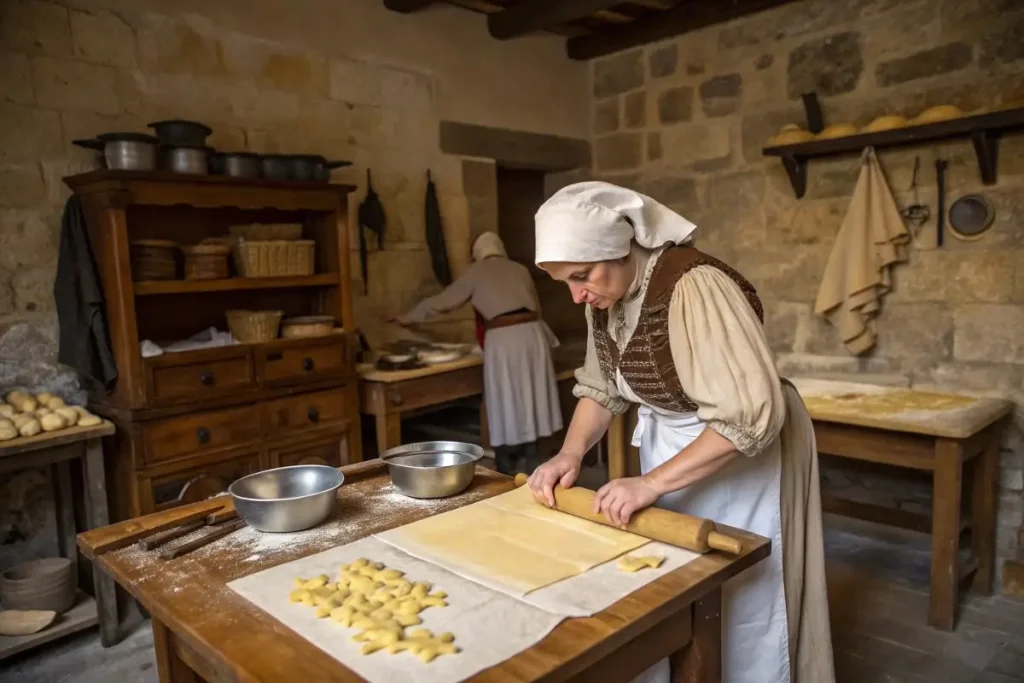
Is farfalle the same as bow tie? Farfalle’s story begins in Northern Italy, particularly in the Emilia-Romagna and Lombardy regions. Although exact details are sometimes debated, most culinary historians agree that the pasta dates back to the 16th century. At the time, resourceful homemakers created this shape from leftover pasta dough, thus ensuring nothing went to waste. Over time, the shape endured, evolving into a beloved staple that transcended its humble origins.
Culinary Evolution
- 16th Century Beginnings: Initially, families handcrafted farfalle, meticulously shaping each piece.
- Regional Specialties: Over the centuries, regions like Emilia-Romagna and Lombardy paired farfalle with rich butter sauces and creamy toppings, thereby highlighting its sauce-holding capacity.
- Modern Adaptations: Today, thanks to advances in production and distribution, farfalle is exported worldwide, influencing global cuisine.
What is Bow Tie Pasta ?
Bow tie pasta, as the name suggests, simply refers to the same shape known as farfalle. However, this term became popular primarily in the United States, where the pasta’s resemblance to a formal bow tie resonated more strongly than the idea of butterflies. Consequently, “bow tie pasta” evolved as a colloquial, culturally familiar label that often appears in American recipes, cookbooks, and grocery stores.
Bow Tie Pasta’s Popularity in the U.S.
- Playful Appearance: Because it looks like a bow tie, children and families find it fun and approachable.
- Versatility in American Cuisine: It appears frequently in pasta salads, casseroles, and soups, thus appealing to various palates.
- Brand Recognition: As a result of its catchy name, many American pasta brands market farfalle under the bow tie label, making it easily recognizable.
Farfalle vs Bow Tie: Is farfalle the same as bow tie?
Is farfalle the same as bow tie? Yes, farfalle and bow tie pasta refer to the exact same shape. In other words, there is no structural difference. Instead, the distinction lies primarily in linguistic and cultural conventions. In Italy and most of Europe, people use the term farfalle, reflecting the pasta’s original identity. Conversely, Americans often call it bow tie pasta, creating a more relatable image. Ultimately, both names describe the same delightful shape, ensuring that whether you choose to say “farfalle” or “bow tie,” you’ll be cooking with an equally versatile and charming pasta.
Cultural and Linguistic Differences
- Italian Origin: Since Italians named it after butterflies, their term farfalle is directly connected to its aesthetic.
- American Usage: By contrast, calling it bow tie pasta relies on a familiar item of clothing.
- Global Understanding: Even though the names differ, cooks worldwide recognize that these two terms are interchangeable.
Culinary Uses of Farfalle (Bow Tie Pasta)
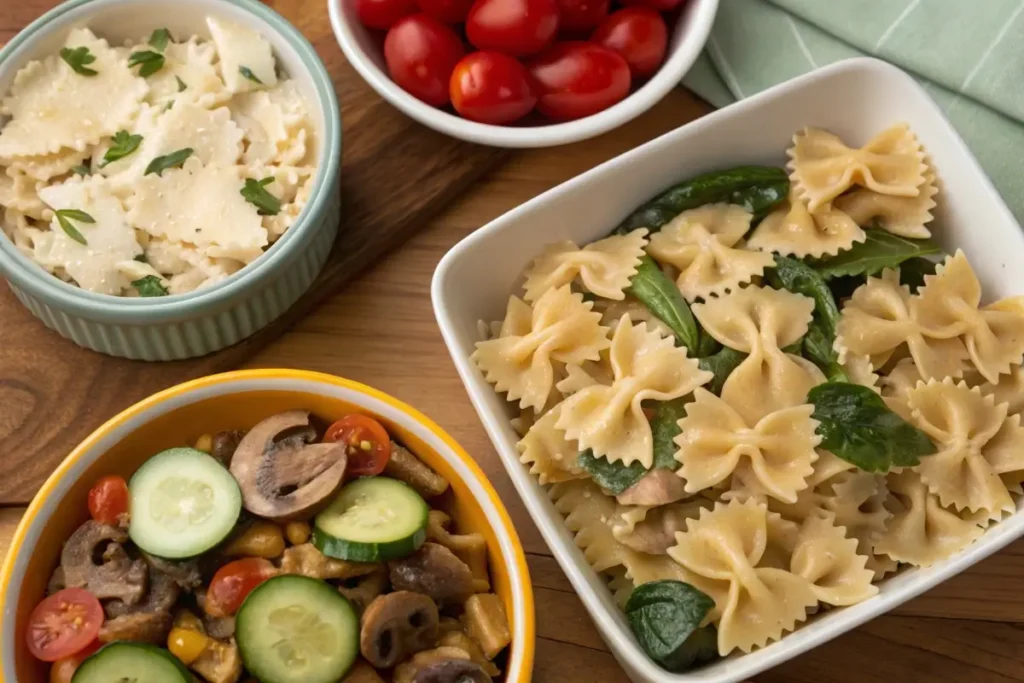
Farfalle’s adaptability allows it to shine in multiple culinary contexts. For instance, it is delicious in warm, comforting meals, but it also thrives in chilled pasta salads. Moreover, its shape and texture easily embrace both delicate and robust flavors.
Perfect Pairings
- Sauces: Because its shape clings to sauces effectively, creamy Alfredo, zesty marinara, and tangy pesto complement it beautifully.
- Proteins: Furthermore, grilled chicken, shrimp, sautéed mushrooms, or browned sausage all work harmoniously with farfalle.
- Vegetables: Similarly, broccoli florets, cherry tomatoes, bell peppers, and zucchini complement the pasta’s neutral yet appealing backdrop.
Farfalle in Salads
Due to its form, farfalle excels in pasta salads, readily holding onto vinaigrettes and dressings:
- Classic Italian Pasta Salad: Incorporate olives, mozzarella pearls, salami, and cherry tomatoes to create a colorful, crowd-pleasing dish.
- Light Summer Salad: In addition, mix it with spinach, feta cheese, lemon vinaigrette, and fresh herbs for a refreshing, warm-weather meal.
- Mediterranean-Inspired Salad: Alternatively, try artichoke hearts, sun-dried tomatoes, capers, and arugula to introduce complex flavors and textures.
In Soups and Casseroles
Thanks to its sturdy shape, farfalle also works well in soups and casseroles:
- Soups: Add it to minestrone, chicken noodle soup, or vegetable stews to bring heartiness and interest to each spoonful.
- Casseroles: Layer farfalle with cheese, vegetables, and sauce, thereby creating a comforting baked dish that appeals to all ages.
How to Cook Farfalle to Perfection
Cooking farfalle correctly ensures that it retains its appealing texture. First, start by bringing a large pot of salted water to a rolling boil. Next, stir in the farfalle and cook for 10–12 minutes, following package instructions. During this process, occasionally taste a piece to ensure it reaches the desired al dente firmness. Finally, drain the pasta and toss it immediately with olive oil or sauce.
Tips for Cooking Farfalle
- Use Enough Water: In order to prevent clumping, use 4–6 quarts of water per pound of pasta.
- Salt the Water: By seasoning the water, you infuse flavor into the pasta itself.
- Reserve Pasta Water: Moreover, save a small amount of starchy cooking water to help thicken and bind your sauce later.
Nutritional Information
Farfalle provides a source of carbohydrates, protein, and some essential nutrients. Thus, it can easily fit into a balanced diet.
| Nutrient | Amount Per Serving (1 cup cooked farfalle) |
|---|---|
| Calories | ~200 |
| Carbohydrates | ~42g |
| Protein | ~7g |
| Fat | ~1g |
| Fiber | ~2g |
| Iron | ~10% DV |
Health Tips
- Portion Control: Although pasta is delicious, moderating your portion size ensures a well-balanced meal.
- Whole Wheat Options: Furthermore, opt for whole wheat farfalle to increase fiber and nutrient content.
- Gluten-Free Varieties: For individuals with gluten sensitivities, several brands now offer gluten-free farfalle made from rice, quinoa, or chickpea flour.
Creative Farfalle Recipes to Try
Instead of sticking to the basics, consider exploring more inventive recipes. For example, you can introduce new flavors and ingredients to keep your meals exciting.
Creamy Garlic Chicken Farfalle
- Ingredients: Combine grilled chicken, garlic, Parmesan cheese, and heavy cream to yield a rich, comforting dish.
- Pairings: Serve with a leafy green salad, crusty bread, and a crisp white wine to complete the meal.
Pesto Farfalle with Roasted Vegetables
- Ingredients: Toss roasted zucchini, cherry tomatoes, and bell peppers with farfalle and fresh basil pesto for a bright, herbaceous flavor profile.
- Pairings: Accompany this dish with grilled fish or chicken, and a chilled glass of Pinot Grigio.
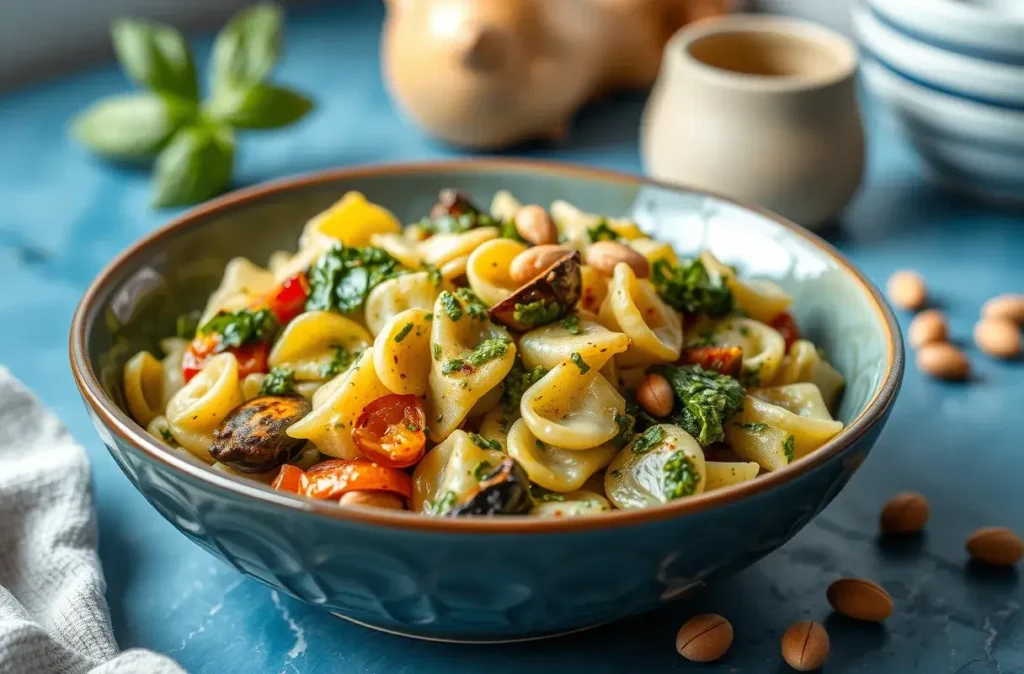
Bow Tie Pasta Primavera
- Ingredients: Incorporate seasonal vegetables—such as asparagus, peas, and carrots—alongside a light olive oil or butter sauce.
- Pairings: Enjoy it in spring and summer, sipping on a light-bodied white wine or sparkling water with citrus.
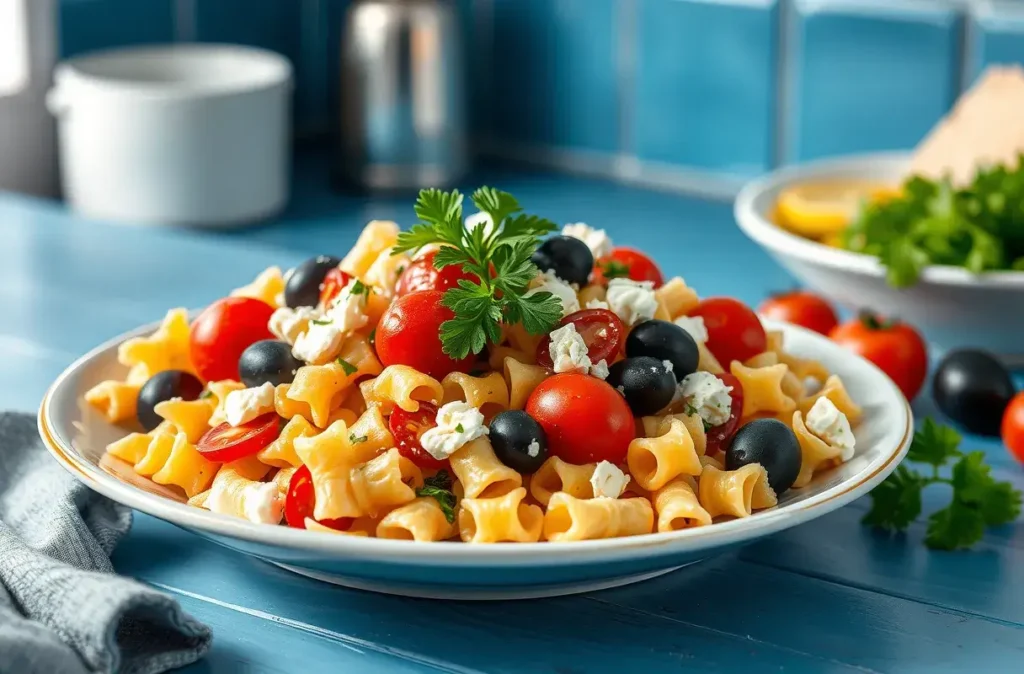
Frequently Asked Questions
What sauces work best with farfalle?
Because farfalle is so adaptable, it pairs well with both creamy and lighter sauces, such as Alfredo, tomato basil, or pesto.
Can farfalle be gluten-free?
Yes, many brands now produce gluten-free farfalle from alternative flours, thereby accommodating those with dietary restrictions.
Is farfalle suitable for soups?
Absolutely! Its sturdy shape holds up well in hearty soups, adding both substance and visual interest.
What’s the difference between farfalle and other pasta shapes?
Unlike smoother forms, farfalle’s butterfly shape and pinched center capture flavors more effectively, thereby enhancing each bite.
What Does Farfalle Mean in Italy?
In Italian, farfalle translates to “butterflies,” reflecting the pasta’s wing-like shape Read the Full Article.
What Do Italians Use Farfalle For?
Italians use farfalle in a range of dishes. Creamy sauces like Alfredo or a simple butter and sage sauce are popular, as are lighter, oil-based preparations or chilled pasta salads Read the Full Article.
Beyond Italy: Farfalle’s Global Appeal
While farfalle’s roots are distinctly Italian, its popularity has spread across the globe. In fact, many cultures have embraced farfalle and integrated it into their culinary traditions. As a result, you’ll encounter farfalle in fusion dishes, inventive salads, and even unconventional stir-fries.
Cultural Adaptations
- United States: Often known as bow tie pasta, it appears in picnic-friendly salads, creamy casseroles, and family-focused weeknight meals.
- Eastern Europe: Conversely, you might find farfalle served with sautéed mushrooms, onions, and herbs, reflecting regional flavors.
- Asia: In some fusion recipes, farfalle mingles with soy-ginger dressings, stir-fried vegetables, and spicy sauces, thus showcasing its versatility.
Comparing Farfalle with Other Pasta Shapes
If you’re curious about how farfalle differs from other types of pasta, consider the following comparisons:
- Fusilli (Rotini): Although fusilli’s spirals also hold sauce well, farfalle’s pinched center creates a distinct textural contrast.
- Penne: While penne’s tube shape is perfect for baked dishes, it lacks the “wings” that set farfalle apart visually.
- Orecchiette: Although orecchiette (“little ears”) cup sauces, they do not provide the same symmetrical elegance or firm center as farfalle.
Homemade Farfalle: The Art of Pasta-Making
For those seeking a culinary adventure, consider making farfalle from scratch. Although it’s more time-consuming, the effort pays off with fresh, tender pasta that you can customize to your liking.
Steps to Make Homemade Farfalle
- Prepare the Dough: Mix durum wheat semolina flour and water, or choose a blend of all-purpose flour and eggs for added richness.
- Roll Out the Dough: Use a pasta machine or rolling pin to achieve the desired thickness.
- Cut and Shape: Cut the dough into rectangles and pinch the centers to form the butterfly shape.
- Drying and Storing: Finally, lay out the freshly made farfalle on a floured surface. You can cook it immediately, or dry it for future use.
Storing and Preserving Farfalle
Whether dried or cooked, proper storage ensures that your farfalle remains fresh and delicious.
Dry Farfalle:
- Store unopened packages in a cool, dry place for up to two years. After opening, use airtight containers to preserve quality.
Cooked Farfalle:
- Refrigerate leftovers in an airtight container for 3–4 days. Reheat gently with a splash of water or broth.
- Alternatively, freeze cooked farfalle after tossing it in a bit of olive oil. This method preserves texture for up to 1–2 months.
Sustainability and Ethical Considerations
As sustainability concerns grow, choosing ethically sourced pasta has become increasingly important. Thus, consider looking for brands that support local wheat farmers, use eco-friendly packaging, and employ responsible production methods.
- Look for Certifications: Organic or Non-GMO labels indicate higher-quality wheat and fewer chemical inputs.
- Local Suppliers: By supporting small-scale producers, you reduce transportation emissions and bolster regional economies.
- Environmentally Friendly Packaging: Some brands now experiment with biodegradable packaging, thereby reducing environmental impact.
Pairing Farfalle with Beverages
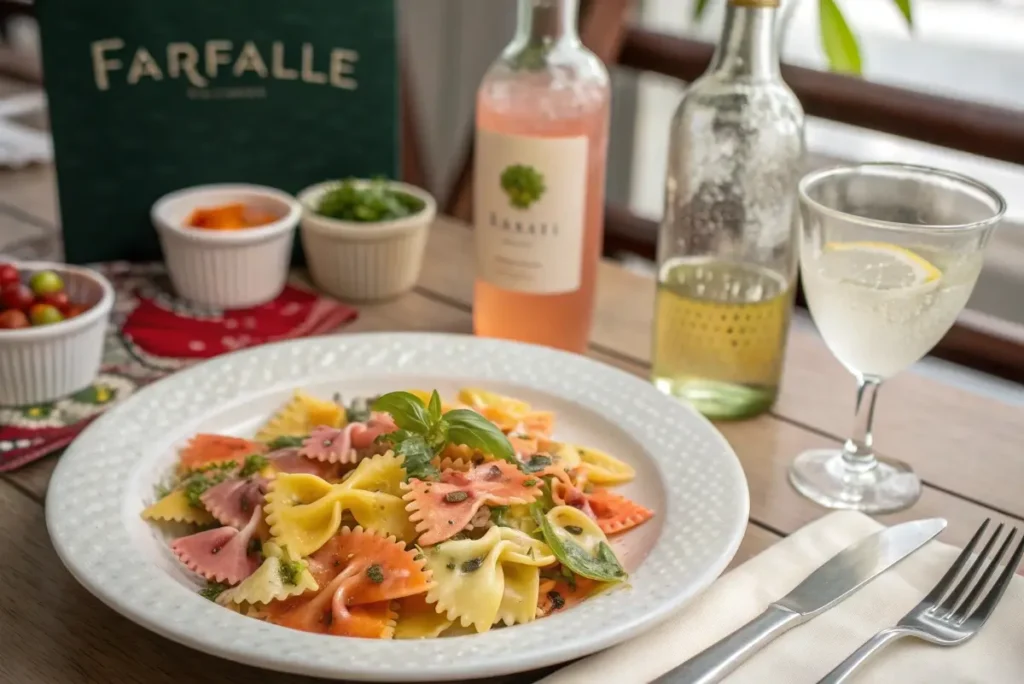
Enhance your farfalle dishes by pairing them with the right beverage:
- Light Whites: Crisp wines like Pinot Grigio or Sauvignon Blanc complement pesto-based or vegetable-oriented dishes.
- Medium-Bodied Reds: Chianti or Barbera pair nicely with tomato-based sauces or creamy chicken farfalle.
- Non-Alcoholic Options: Sparkling water with lemon, herbal iced teas, or a light lemonade refresh the palate, especially for lighter salads.
Hosting with Farfalle: Entertaining Ideas
Because of its appealing shape, farfalle suits a variety of entertaining scenarios:
- Themed Parties: Arrange a “butterfly garden” brunch, serving farfalle salads alongside floral decorations.
- Family Gatherings: Its kid-friendly shape encourages children to enjoy pasta dishes without hesitation.
- Potluck Favorites: Farfalle-based salads travel well, remaining attractive and tasty on buffet tables.
Regional Variations in Serving Farfalle
In Italy, the approach to farfalle often depends on the season:
- Spring: Light, vegetable-driven farfalle primavera celebrates fresh peas and asparagus.
- Summer: Cool pasta salads with basil, tomatoes, and mozzarella evoke the bounty of the garden.
- Fall and Winter: During cooler months, farfalle may be paired with creamy mushroom sauces or hearty ragùs, creating warming comfort foods.
Culinary Creativity: Beyond Traditional Recipes
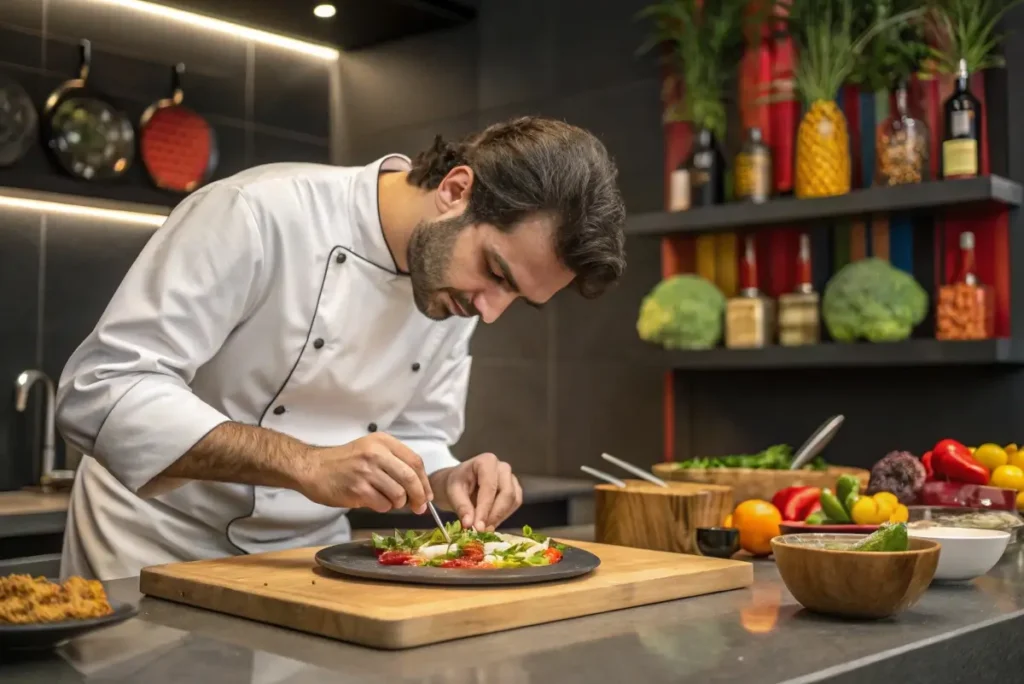
Why limit yourself to traditional dishes? Consider experimenting with farfalle in unexpected ways:
- Stir-Fries: Toss cooked farfalle into stir-fries with vegetables, sesame oil, and a splash of soy sauce for a fun fusion twist.
- Pasta Frittatas: Combine leftover farfalle with eggs, cheese, and herbs to create a hearty brunch favorite.
- Sweet Dishes: Though uncommon, adventurous chefs have tried pairing farfalle with sweet sauces or fruit compotes, pushing the culinary boundaries.
Conclusion: Is Farfalle the Same as Bow Tie?
In conclusion, farfalle and bow tie pasta are indeed one and the same. Although different cultures have chosen distinct names, the pasta shape and culinary possibilities remain unchanged. Ultimately, whether you embrace the Italian butterfly imagery or the American formalwear analogy, you’ll be enjoying a versatile pasta that adapts to countless flavors, cooking styles, and occasions.
As you experiment in your kitchen, remember that this pasta’s enduring popularity stems from centuries of culinary tradition, practical design, and universal appeal. Above all, farfalle encourages creativity, invites family gatherings, and brightens any dish with its unique shape and texture. Next time you prepare a meal, consider choosing farfalle, secure in the knowledge that you can call it by whatever name best suits your culinary narrative—because in every sense, it remains the delightful, flavorful pasta we all love.
